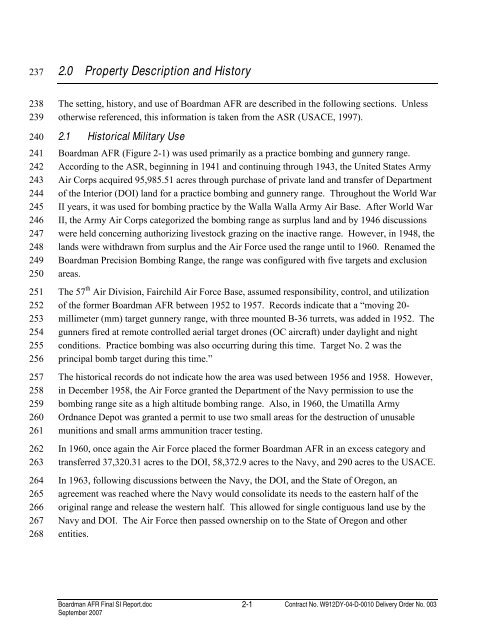FINAL SITE INSPECTION REPORT
FINAL SITE INSPECTION REPORT
FINAL SITE INSPECTION REPORT
You also want an ePaper? Increase the reach of your titles
YUMPU automatically turns print PDFs into web optimized ePapers that Google loves.
2372.0 Property Description and History238239240241242243244245246247248249250251252253254255256257258259260261262263264265266267268The setting, history, and use of Boardman AFR are described in the following sections. Unlessotherwise referenced, this information is taken from the ASR (USACE, 1997).2.1 Historical Military UseBoardman AFR (Figure 2-1) was used primarily as a practice bombing and gunnery range.According to the ASR, beginning in 1941 and continuing through 1943, the United States ArmyAir Corps acquired 95,985.51 acres through purchase of private land and transfer of Departmentof the Interior (DOI) land for a practice bombing and gunnery range. Throughout the World WarII years, it was used for bombing practice by the Walla Walla Army Air Base. After World WarII, the Army Air Corps categorized the bombing range as surplus land and by 1946 discussionswere held concerning authorizing livestock grazing on the inactive range. However, in 1948, thelands were withdrawn from surplus and the Air Force used the range until to 1960. Renamed theBoardman Precision Bombing Range, the range was configured with five targets and exclusionareas.The 57 th Air Division, Fairchild Air Force Base, assumed responsibility, control, and utilizationof the former Boardman AFR between 1952 to 1957. Records indicate that a moving 20-millimeter (mm) target gunnery range, with three mounted B-36 turrets, was added in 1952. Thegunners fired at remote controlled aerial target drones (OC aircraft) under daylight and nightconditions. Practice bombing was also occurring during this time. Target No. 2 was theprincipal bomb target during this time.The historical records do not indicate how the area was used between 1956 and 1958. However,in December 1958, the Air Force granted the Department of the Navy permission to use thebombing range site as a high altitude bombing range. Also, in 1960, the Umatilla ArmyOrdnance Depot was granted a permit to use two small areas for the destruction of unusablemunitions and small arms ammunition tracer testing.In 1960, once again the Air Force placed the former Boardman AFR in an excess category andtransferred 37,320.31 acres to the DOI, 58,372.9 acres to the Navy, and 290 acres to the USACE.In 1963, following discussions between the Navy, the DOI, and the State of Oregon, anagreement was reached where the Navy would consolidate its needs to the eastern half of theoriginal range and release the western half. This allowed for single contiguous land use by theNavy and DOI. The Air Force then passed ownership on to the State of Oregon and otherentities.Boardman AFR Final SI Report.doc 2-1 Contract No. W912DY-04-D-0010 Delivery Order No. 003September 2007
















